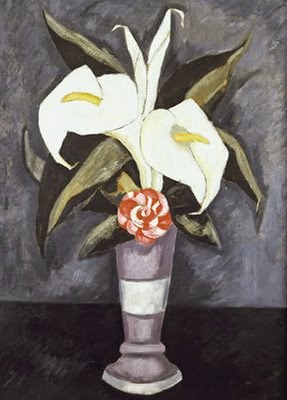 AG: Marsden Hartley…it was recommended that I should look at his poetry also, because I was looking for examples of free-form poetry in English, and Marsden Hartley was one of the first, and one of the most loose relaxed and straightforward natural poets that ever wrote in this form. His form is a little bit..it’s one of the rare examples of real “free” verse, where the guy is writing very directly and straightforwardly with an eye on the object. Doing what (William Carlos) Williams and (Ezra) Pound and (Charles) Reznikoff always wanted to do, but he was a painter and he just did it. He wrote so naturally and so intelligently that it was immediately recognized by Williams and his friends as being great, but a book of his never came out until 1945. Though his paintings had become very famous, because there’s lots of his paintings in the Museum of Modern Art and in every major museum which collects America painting. Some of you can take a look, at the end of (the class) at the book by Hartley..
AG: Marsden Hartley…it was recommended that I should look at his poetry also, because I was looking for examples of free-form poetry in English, and Marsden Hartley was one of the first, and one of the most loose relaxed and straightforward natural poets that ever wrote in this form. His form is a little bit..it’s one of the rare examples of real “free” verse, where the guy is writing very directly and straightforwardly with an eye on the object. Doing what (William Carlos) Williams and (Ezra) Pound and (Charles) Reznikoff always wanted to do, but he was a painter and he just did it. He wrote so naturally and so intelligently that it was immediately recognized by Williams and his friends as being great, but a book of his never came out until 1945. Though his paintings had become very famous, because there’s lots of his paintings in the Museum of Modern Art and in every major museum which collects America painting. Some of you can take a look, at the end of (the class) at the book by Hartley..
This is “Scouting the Fishboat” – and there’s a kind of rough clear, early American, early century American style there

What else has he got? There’s a painting by him of Alfred Pinkham Ryder

a still-life (which is a calla lily – a lily also) (at the Newark Museum)

His paintings are worth more than his poetry on the market because they’re now (worth) a hundred grand each…he’s like a big.. or more. As there was the development of an indigineous American painting style, he was one of the people who contributed to it.
Student: I think he spent the crucial time of his life in Germany
AG: Expressionist era. And so there’s a famous painting of a gull.. Has anybody ever seen any of his painting? Yeah.

Student: There was an exhibit at the Whitney (Museum) a couple of years ago
AG: All Marsden Hartley?
Student: Yeah
AG: Yeah, you can see he’s a big wheel. My favorite painting is one.. well, this is an example, “Painting Number Five, Berlin”(this is back in 1912 – so it’s before (Piet) Mondrian, before Paul Klee’s magic-square paintings also. [Editorial note – 1914-15 so…]
[Audio for the above may be heard here, beginning at the start of the tape and concluding approximately two-and-three-quarter minutes in]

